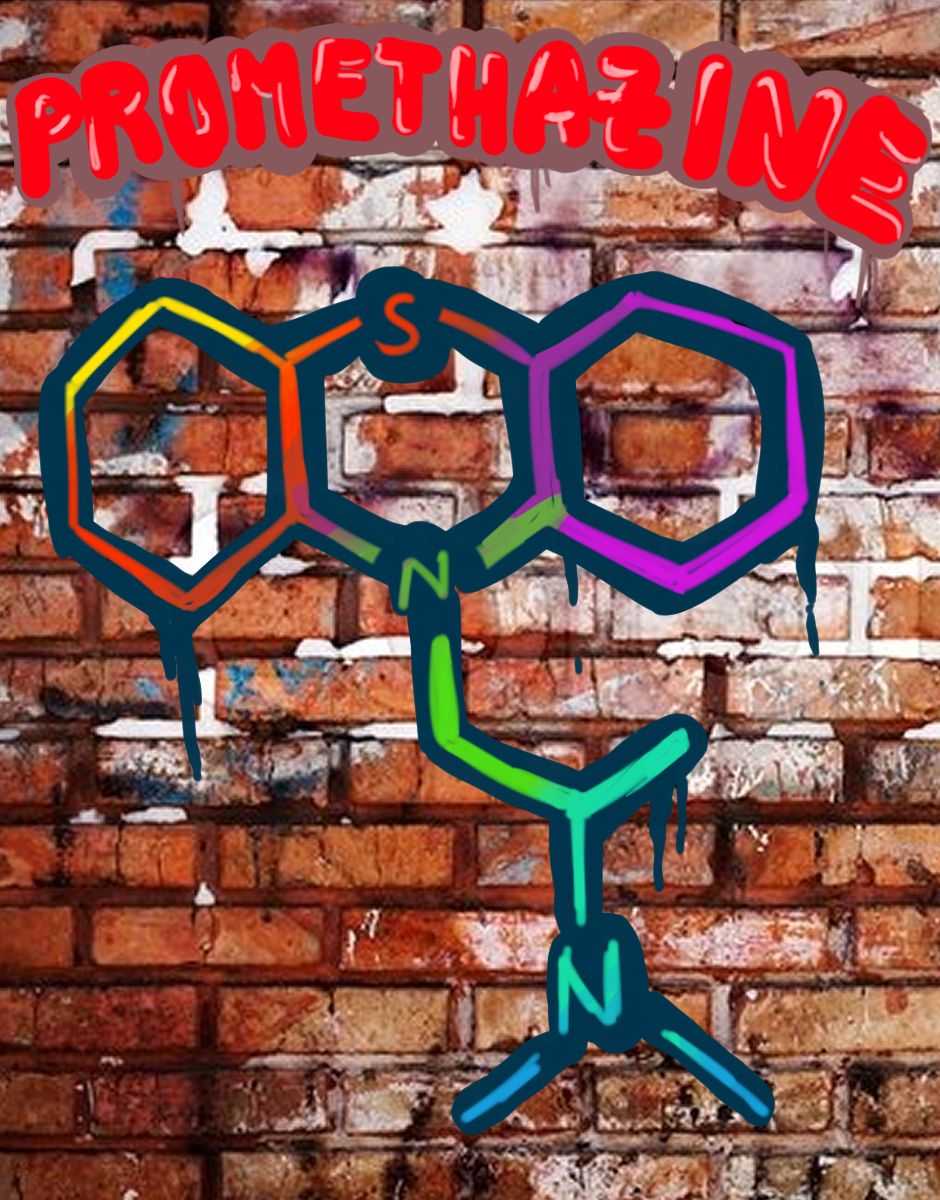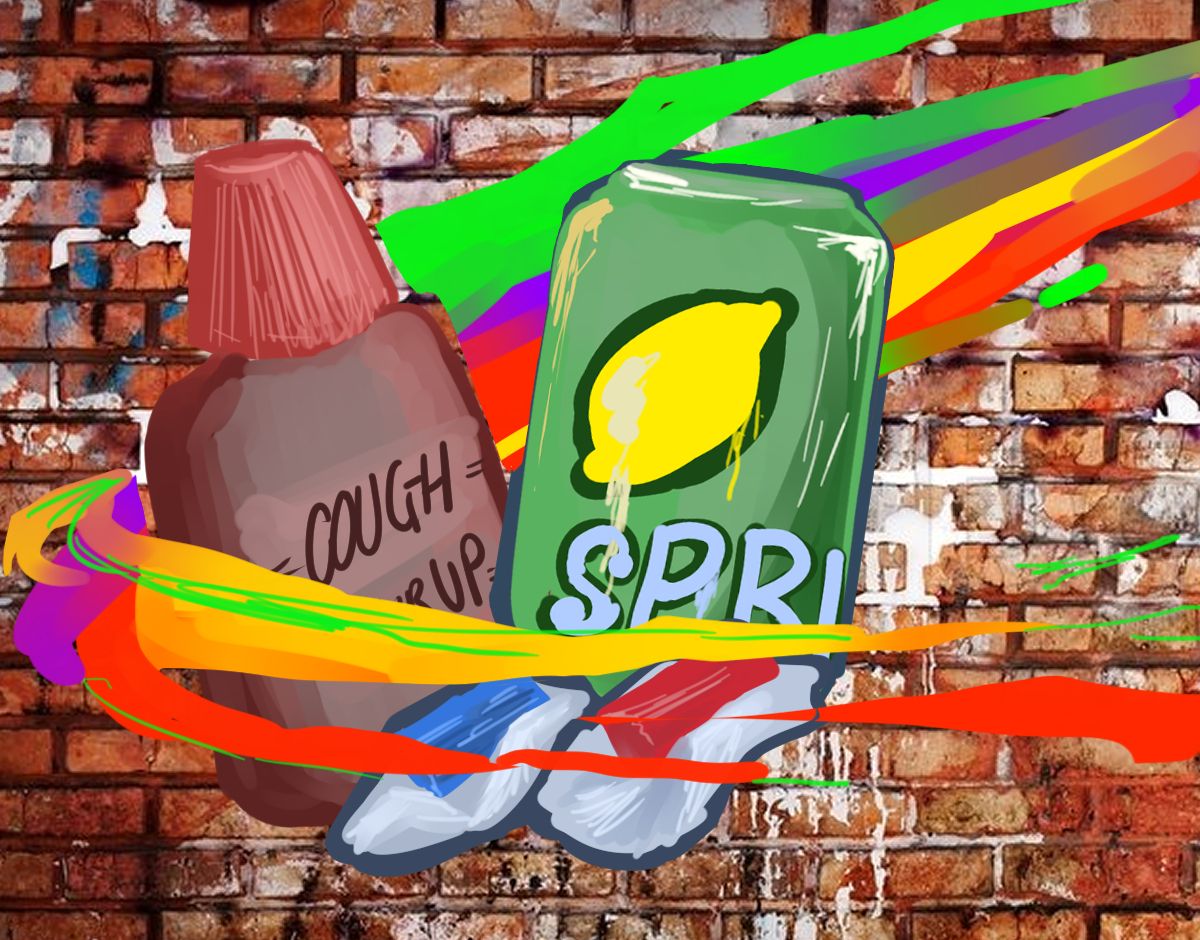We Have Lean On the Beat
Over the last thirty years, hip-hop music has risen from its humble beginnings in inner-city neighborhoods to the center of the mainstream music stage. The genre has not only brought upbeat tempos and clever wordplay, but also an entire subculture forming a lifestyle among its listeners and fans. Beyond the flashy clothes, backwards caps, and shining grills lies another motif found in many rappers’ lyrics today: a psychoactive drug cocktail called “lean”.
“Lean” is a colloquial term for a psychoactive drug cocktail made of codeine and promethazine laden prescription cough syrup, soda, and hard candy [1]. Early lean use was facilitated by the accessibility of cough syrup in poor Houston neighborhoods in the 1960s, but by the early 1990s, cough syrup had been incorporated into lemon-lime sodas and hard candies and became known as the “drug of the poor” throughout the Southeastern United States [2]. Over time, its use has begun to plague youths worldwide. Lean use and frequent references to the drug by hip hop figures and professional athletes in the media and in their song lyrics has spurred a lean epidemic that has contributed to drug-related overdoses and deaths similar to the current opioid epidemic [3].
Prescription cough syrups contain a mix of promethazine and codeine, which act as dual-action pain suppressants and are commonly given to alleviate sore throats and coughing. In excessive amounts, however, promethazine and codeine act as central nervous system (CNS) and respiratory system depressants, leading to feelings of euphoria, shortness of breath, and addiction. Further research on the effects of promethazine and codeine have found that they lower prefrontal cortex volume, increase impulsivity, cause liver damage, and have symptoms resembling opioid overdoses [1][4][5]. In response, the U.S. Food and Drug Administration (FDA) has applied new restrictions on cough syrup prescriptions to youths and issued new warnings on overall cough syrup use [6]. Notable figures in the hip-hop community, such as rappers Future and Juice WRLD, have recently spoken out against lean usage and encouraged other figures to stop referring to the drug in their music. Despite its benign nature, prescription cough syrup has been popularized by modern media and abused by many in a sweet drug cocktail referred to as “lean” to exploit its euphoric and relaxing effects, spurring discussion and research on its true safety and potential for abuse among many impressionable youths worldwide.
Codeine Dreaming
Codeine plays a part in the deadly duet of the active pharmaceutical ingredients that makes prescription cough syrup addictive and fatal. Codeine is an opioid, a class of chemical compounds derived from the opium poppy and related to other illicit drugs such as morphine, heroin, and fentanyl. Similar to these well-known drugs of abuse, codeine causes drowsiness and respiratory depression when consumed in large quantities [7].
Codeine and other opioids achieve these effects by acting as opioid receptor agonists, chemicals that mimic a neurotransmitter’s structure to bind and amplify their signals. Our bodies produce a natural level of human-made opioids, called endogenous opioids, that are responsible for feelings of joy, relaxation, and natural pain relief. When opioid drugs enter our bodies, they mimic the structure of endogenous opioids and bind to the same opioid receptors, amplifying their outgoing signals, causing feelings of numbness, sedation, and euphoria [9]. Prolonged use of opioids dampen the brain’s response to signals sent by opioid receptors, building a tolerance that requires more opioids to produce the same effect. This tolerance leads to a dependence on opioids and addiction with serious withdrawal effects. As more opioids are used to produce the same effects, overdose can occur with symptoms including constricted pupils, shortness of breath (insufficient breathing), unconsciousness, and even seizures.
Codeine is regarded as less dangerous than most other opioids due to how the body breaks it down, or metabolizes, codeine. Codeine is a prodrug, a class of medications that are not pharmacologically active until they are metabolized into an active form. When it is administered, codeine is broken down by our body into morphine, a notoriously strong drug prevalent in the current opioid epidemic. The enzyme Cytochrome P450 2D6 (CYP2D6) breaks codeine down into morphine at varying rates among different individuals depending on the individual’s genetic makeup. About 1 to 2 percent of Americans have genes that translate for ultrafast metabolism of codeine to morphine via CYP2D6, resulting in increased morphine formation after codeine administration and increased vulnerability to morphine overdose and toxicity [9]. It is important to recall that for most individuals, codeine will be metabolized into morphine, a notoriously strong opioid that has the potential for toxicity and overdose wrapped in cough syrup packaging.
In the short term, codeine taken in large amounts can greatly slow one’s breathing to a level that provides insufficient oxygen to maintain consciousness. Prolonged codeine abuse can lead to lasting effects on the brain and an individual’s behavior. In a 2014 study led by researchers at Sun Yat-Sen University in China, the brains of thirty codeine cough syrup addicts were imaged, finding altered brain volumes and synchronization of neural signal firing, or neural integration, in addicts [4]. Codeine addicts were discovered to have reduced volume and neural integration in the prefrontal cortex region, which is the primary decision-making center of the brain [4]. Researchers also examined the behaviors and noted higher scores for impulsivity as measured by…, [4]. Another study done at Peking University found that codeine dependence caused reduced amounts of dopamine transporters in parts of the brain, which help clear our synapses of dopamine after nerve impulses [10]. Decreased amounts of dopamine transporters create a less efficient dopamine cleanup system, contributing to lasting feelings of euphoria and an ever-growing tolerance after each use. Opioid addiction and overdose is currently an epidemic in the United States, with nearly 47,000 deaths related to overdose in 2018, six times the number of overdose-related deaths in 1999 [8]. Notable figures such as rapper Juice WRLD, pop icon Prince, and actor Philip Seymour Hoffman have all died due to opioid overdoses in the past ten years. Many attribute the opioid epidemic to high-strength opioids such as heroin, fentanyl, morphine, and oxycodone, but neglect addiction and overdose cases in weaker opioids like codeine.

Promethazine and Geeking
Promethazine is the second component of the psychoactive duet found in prescription cough syrups. Unlike codeine, promethazine is not an opioid or a prodrug. It is an antihistamine, the same class of drugs used for allergy medication, congestion, and treatment for itchy hives. Promethazine often accompanies codeine in cough syrups to ward off feelings of nausea and brings a sedative effect to lighten pain from sore throats and coughing. It does this by acting as an anticholinergic, which binds and blocks the brain’s receptors for acetylcholine, a major neurotransmitter which helps facilitate muscle movement, attention, and learning [11][12]. Based on its wide range of functions, neural systems that rely on acetylcholine are critical for maintaining many elements of human consciousness and are particularly sensitive. Drugs that interfere with cholinergic systems can have a wide range of severe adverse effects from paralysis to convulsions and psychosis [13]. In large amounts and prolonged use, promethazine can produce side effects including light sensitivity, hyperactive delirium, slurred speech, psychosis, visual and auditory hallucinations, and seizures [13].
Like other psychoactive drugs, the impact of promethazine usage can extend to influence the lives of those other than just the user itself. For example, lean intoxication can impair one’s proper functioning and coordination. A study examining psychomotor performance under the influence of promethazine in twelve British adults found that promethazine “significantly impaired psychomotor performance, information processing and feelings of alertness” [14][15]. Subjects were asked to perform physical tests for psychomotor effects and were surveyed for how they had felt before taking the drug and in two-hour intervals after. Performance under the influence of promethazine was reduced up to eight hours after drug administration, with many reporting difficulty in memorization and slow reaction times [14][15]. This study’s findings apply to dangerous tasks requiring good coordination and alertness, such as driving or operating heavy machinery. Besides visual tests, there is no known method of screening out a driver who is under the influence of prescription cough syrups, nor is there a threshold of how much is deemed safe for a user to continue driving. Lean-intoxicated drivers with impaired alertness can cause fatal motor accidents. Like other psychoactive drugs, promethazine and codeine found in lean can have lasting impacts on others apart from the users themselves.
The combination of codeine and promethazine in prescription cough syrups allows for a high-strength pain reliever for coughing and sore throats, but also high potential for abuse and addiction. Codeine and promethazine both depress activity in the central nervous system and respiratory tract, risking user consciousness and long-term brain function in pursuit of fleeting highs and euphorias. Moreover, prescription cough syrup’s reputation as a harmless pain reliever contributes to the lack of awareness of many to its potential for abuse as a narcotic. Doctors and pharmacists could prescribe cough syrups with promethazine and codeine to naive patients of all ages, potentially creating a new set of addicts if they are not informed about the drug’s risks and side effects.

A Drug Epidemic on Pharmacy Shelves
Lean began as a “drug of the poor” in the Southeastern United States during the 1960s, where easy access without prescription to cough syrups in lower-class neighborhoods saw the drug out in the streets and among poor youths in inner-city communities. Cough syrups were then combined with sodas and candies to ward off any off-putting aftertaste. Lean soon became part of street culture within the region, becoming known as “Texas Tea” and “sizzurp” [2]. This rise in popularity coincided with the rise of hip-hop music and culture that occurred in the same communities [2]. Southeastern hip-hop artists such as Three 6 Mafia and Lil Wayne began speaking unapologetically about lean usage, with the former producing the chart-topping record “Sippin’ on Some Sizzurp”, becoming a hit among urban youths and putting lean center stage in the hard-partying persona of hip-hop.
As hip-hop music and culture spread worldwide, so did lean usage. A study of adolescent abusers in Hong Kong found that youths sought lean usage out of peer pressure, easy access and availability, to detach themselves from family or personal issues, or out of plain ignorance [16]. Widespread youth unemployment in Zimbabwe and Nigeria have led many youths to abusing lean to pass time. A study done at a major university in the Southern United States had found that lean usage and abuse was found disproportionately more in urban males of color [17]. Furthermore, as many as 8.3 percent of all Texas adolescents have been reported to have tried lean [17].
With significant portions of youths in many countries abusing prescription cough syrups, it is mystifying how little has been done to warn many of the dangers of using these drugs. The market for cough syrups, over-the-counter and prescription, is now worth over fifteen billion dollars [18]. Opioid medications, such as codeine found in cough syrups, comprise a $25.4 billion industry that big pharmaceutical companies spend millions per year on top of production to lobby and advocate for prescription and administration of opioid drugs [19]. In February 2021, global management consulting firm McKinsey & Company reached a $571 million settlement with all fifty United States state governments in response to their role in advising big pharma companies to push more high-risk opioid sales (including codeine) [20]. There is a blatant and dehumanizing greed in pharmaceutical companies that target many through offering ephemeral highs stocked on pharmacy shelves.

Several high-profile arrests and deaths attributed to lean have begun to reshape the vision of lean for many, discouraging the abuse of cough syrups after seeing their potential for abuse. Rapper Pimp C of hip-hop duo UGK died of a cough syrup overdose in his hotel room in 2008 next to large amounts of lean. Grammy-award winning rapper Lil Wayne has also been hospitalized with seizures related to his lean use. Rapper Fredo Santana, cousin of Chicago rapper Chief Keef, was rushed to the hospital over three times due to seizures and liver and kidney failure stemming from his lean abuse, ultimately dying in 2018 from cardiovascular failure linked to it. Former Oakland Raiders quarterback JaMarcus Russell was arrested and charged with unlawful possession of prescription cough syrups in 2010, and had even tested positive for codeine during the 2007 NFL draft [17]. As drug overdose and abuse becomes to take over many lives in the hip-hop community, rappers such as Future and Juice WRLD have begun to speak out against drugs like lean, citing that their lyrics have begun problematic as youths become influenced to try drugs.
Despite the behemoth that is popular media changing its discourse on lean usage, it alone is not enough to prevent potential abuse of cough syrups via lean or other forms. Fortunately, the United States Food and Drug Administration has tightened up the sale of codeine-promethazine cough syrups to the public, issued official warnings to consumers, and barred its prescription to patients under the age of eighteen [21]. Drug education in the United States has also begun to include opioids and community resources are available for those with cough syrup addiction. The landmark McKinsey & Company opioid case alongside settlements with other cough syrup and opioid manufacturers shines a glimmer of hope that pharmaceutical companies are more weary of their drugs’ risks. It is difficult to deter the use of medications as widely beneficial for common symptoms of illness as cough syrup, but it does prompt discussion on how we can make our drugs safer and less risky to help communities in need.
References
- Miuli, A., Stigliano, G., Lalli, A., Coladonato, M., D’Angelo, L., Esposito, F., Cappello, C., Pettorruso, M., Martinotti, G., Schifano, F., & Di Giannantonio, M. (2020). “Purple drank” (Codeine and promethazine cough syrup): A systematic review of a social phenomenon with medical implications. Journal of Psychoactive Drugs, 52(5), 453-462. https://doi.org/10.1080/02791072.2020.1797250
- Elwood, W. N. (2001). Sticky business: Patterns of procurement and misuse of prescription cough syrup in Houston. Journal of Psychoactive Drugs, 33(2), 121-133. https://doi.org/10.1080/02791072.2001.10400477
- Tettey, N., Siddiqui, K., Llamoca, H., Nagamine, S., & Ahn, S. (2020). Purple drank, Sizzurp, and lean: Hip-hop music and codeine use, a call to action for public health educators. International Journal of Psychological Studies, 12(1), 42. https://doi.org/10.5539/ijps.v12n1p42
- Qiu, Y., Lv, X., Jiang, G., Su, H., Yu, T., Tian, J., Zhang, X., & Zhuo, F. (2014). Reduced ventral medial prefrontal cortex (vmPFC) volume and impaired vmpfc-default mode network integration in codeine-containing cough syrups users. Drug and Alcohol Dependence, 134, 314-321. https://doi.org/10.1016/j.drugalcdep.2013.10.023
- Gerardi, D. M., Murphy, T. K., Toufexis, M., & Hanks, C. (2015). Serotonergic or anticholinergic Toxidrome. Pediatric Emergency Care, 31(12), 846-850. https://doi.org/10.1097/pec.0000000000000515
- FDA drug safety communication: FDA restricts use of prescription codeine pain and cough medicines and tramadol pain medicines in children; recommends against use in breastfeeding women | FDA. (2018, March 8). U.S. Food and Drug Administration. https://www.fda.gov/drugs/drug-safety-and-availability/fda-drug-safety-communication-fda-restricts-use-prescription-codeine-pain-and-cough-medicines-and
- Frick, S., Kramell, R., Schmidt, J., Fist, A. J., & Kutchan, T. M. (2005). Comparative qualitative and quantitative determination of alkaloids in narcotic and Condiment Papaver Somniferum Cultivars. Journal of Natural Products, 68(5), 666-673. https://doi.org/10.1021/np0496643
- Centers for Disease Control. (2020, March 19). Opioid data analysis and resources. Centers for Disease Control and Prevention. https://www.cdc.gov/drugoverdose/data/analysis.html
- Crews, K. R., Gaedigk, A., Dunnenberger, H. M., Klein, T. E., Shen, D. D., Callaghan, J. T., Kharasch, E. D., & Skaar, T. C. (2011). Clinical Pharmacogenetics implementation consortium (Cpic) guidelines for codeine therapy in the context of cytochrome p450 2d6 (Cyp2d6) genotype. Clinical Pharmacology & Therapeutics, 91(2), 321-326. https://doi.org/10.1038/clpt.2011.287
- Hou, H., Yin, S., Jia, S., Hu, S., Sun, T., Chen, Q., & Fan, R. (2011). Decreased striatal dopamine transporters in codeine-containing cough syrup abusers. Drug and Alcohol Dependence, 118(2-3), 148-151. https://doi.org/10.1016/j.drugalcdep.2011.03.011
- Naicker, P., Anoopkumar-Dukie, S., Grant, G. D., & Kavanagh, J. J. (2017). Anticholinergic activity in the nervous system: Consequences for visuomotor function. Physiology & Behavior, 170, 6-11. https://doi.org/10.1016/j.physbeh.2016.12.010
- Himmelheber AM, Sarter M, Bruno JP (June 2000). "Increases in cortical acetylcholine release during sustained attention performance in rats". Brain Res Cogn Brain Res. 9 (3): 313–25. doi:10.1016/S0926-6410(00)00012-4. PMID 10808142.
- Gerardi, D. M., Murphy, T. K., Toufexis, M., & Hanks, C. (2015). Serotonergic or anticholinergic Toxidrome. Pediatric Emergency Care, 31(12), 846-850. https://doi.org/10.1097/pec.0000000000000515
- Gastinger, M. J., Tian, N., Horvath, T., & Marshak, D. W. (2006). Retinopetal axons in mammals: Emphasis on histamine and serotonin. Current Eye Research, 31(7-8), 655-667. https://doi.org/10.1080/02713680600776119
- Parrott, A., & Wesnes, K. (1987). Promethazine, scopolamine and cinnarizine: Comparative time course of psychological performance effects. Psychopharmacology, 92(4). https://doi.org/10.1007/bf00176487
- Shek, D. T., & Lam, C. (2006). Adolescent cough medicine abuse in Hong Kong: Implications for the design of positive youth development programs in Hong Kong. International Journal of Adolescent Medicine and Health, 18(3). https://doi.org/10.1515/ijamh.2006.18.3.493
- Agnich, L. E., Stogner, J. M., Miller, B. L., & Marcum, C. D. (2013). Purple drank prevalence and characteristics of misusers of codeine cough syrup mixtures. Addictive Behaviors, 38(9), 2445-2449. https://doi.org/10.1016/j.addbeh.2013.03.020
- Ibis World. (2020, August 31). Cough & Cold Medicine Manufacturing Industry in the US - Market Research Report. IBISWorld - Industry Market Research, Reports, & Statistics. https://www.ibisworld.com/united-states/market-research-reports/cough-cold-medicine-manufacturing-otc-industry/
- Grand View Research, Inc. (2019). Opioids Market Size, Share & Trends Analysis Report By Product (IR/ Short-acting, ER/Long-acting), By Application (Pain Relief, Anesthesia), By Region, And Segment Forecasts, 2019 - 2026. https://www.grandviewresearch.com/industry-analysis/opioids-market
- Mann, B. (2021, February 4). Consulting Giant McKinsey To Settle States' Opioid Claims For $573 Million. National Public Radio. https://www.npr.org/2021/02/04/963864747/consulting-giant-mckinsey-to-settle-opioid-claims-for-573-millionFDA drug safety communication: FDA restricts use of prescription codeine pain and cough medicines and tramadol pain medicines in children; recommends against use in breastfeeding women | FDA. (2018, March 8). U.S. Food and Drug Administration. https://www.fda.gov/drugs/drug-safety-and-availability/fda-drug-safety-communication-fda-restricts-use-prescription-codeine-pain-and-cough-medicines-and

